BSc Business Management: Applied Business Finance Report BMP3005
VerifiedAdded on 2023/06/11
|13
|2921
|180
Report
AI Summary
This report provides a comprehensive analysis of financial management concepts, emphasizing their importance in organizational success. It delves into the main financial statements, including the balance sheet, income statement, and cash flow statement, explaining the use of financial ratios for performance evaluation. The report includes a practical application by completing a business review template, producing an income statement and balance sheet using provided case study data. Furthermore, it assesses the profitability, liquidity, and efficiency of the case study company based on ratio analysis results, offering insights into potential strategies for improving financial performance. The analysis encompasses profitability ratios, liquidity ratios, and efficiency ratios, providing a holistic view of the company's financial health and operational effectiveness.
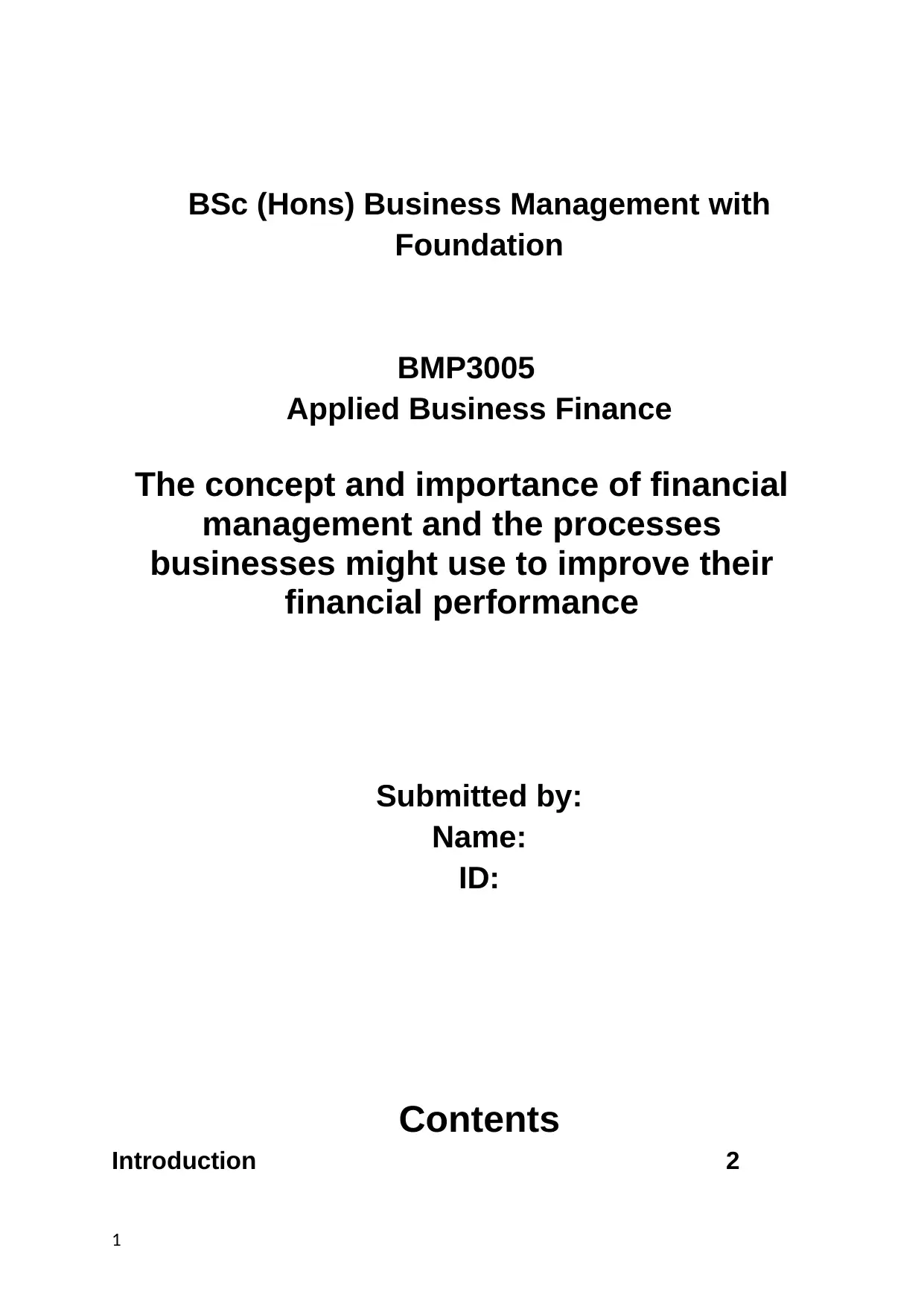
BSc (Hons) Business Management with
Foundation
BMP3005
Applied Business Finance
The concept and importance of financial
management and the processes
businesses might use to improve their
financial performance
Submitted by:
Name:
ID:
Contents
Introduction 2
1
Foundation
BMP3005
Applied Business Finance
The concept and importance of financial
management and the processes
businesses might use to improve their
financial performance
Submitted by:
Name:
ID:
Contents
Introduction 2
1
Paraphrase This Document
Need a fresh take? Get an instant paraphrase of this document with our AI Paraphraser
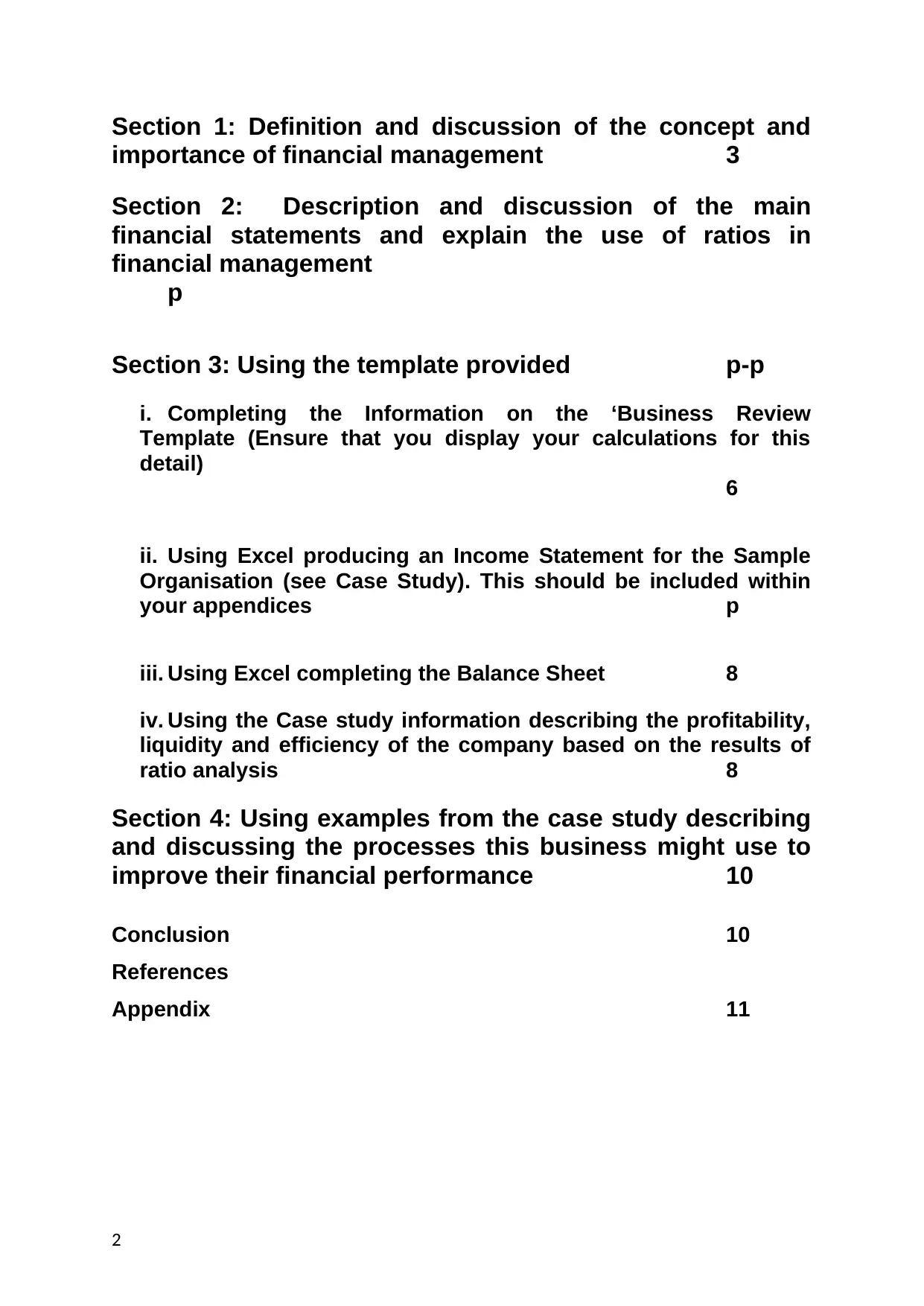
Section 1: Definition and discussion of the concept and
importance of financial management 3
Section 2: Description and discussion of the main
financial statements and explain the use of ratios in
financial management
p
Section 3: Using the template provided p-p
i. Completing the Information on the ‘Business Review
Template (Ensure that you display your calculations for this
detail)
6
ii. Using Excel producing an Income Statement for the Sample
Organisation (see Case Study). This should be included within
your appendices p
iii. Using Excel completing the Balance Sheet 8
iv. Using the Case study information describing the profitability,
liquidity and efficiency of the company based on the results of
ratio analysis 8
Section 4: Using examples from the case study describing
and discussing the processes this business might use to
improve their financial performance 10
Conclusion 10
References
Appendix 11
2
importance of financial management 3
Section 2: Description and discussion of the main
financial statements and explain the use of ratios in
financial management
p
Section 3: Using the template provided p-p
i. Completing the Information on the ‘Business Review
Template (Ensure that you display your calculations for this
detail)
6
ii. Using Excel producing an Income Statement for the Sample
Organisation (see Case Study). This should be included within
your appendices p
iii. Using Excel completing the Balance Sheet 8
iv. Using the Case study information describing the profitability,
liquidity and efficiency of the company based on the results of
ratio analysis 8
Section 4: Using examples from the case study describing
and discussing the processes this business might use to
improve their financial performance 10
Conclusion 10
References
Appendix 11
2
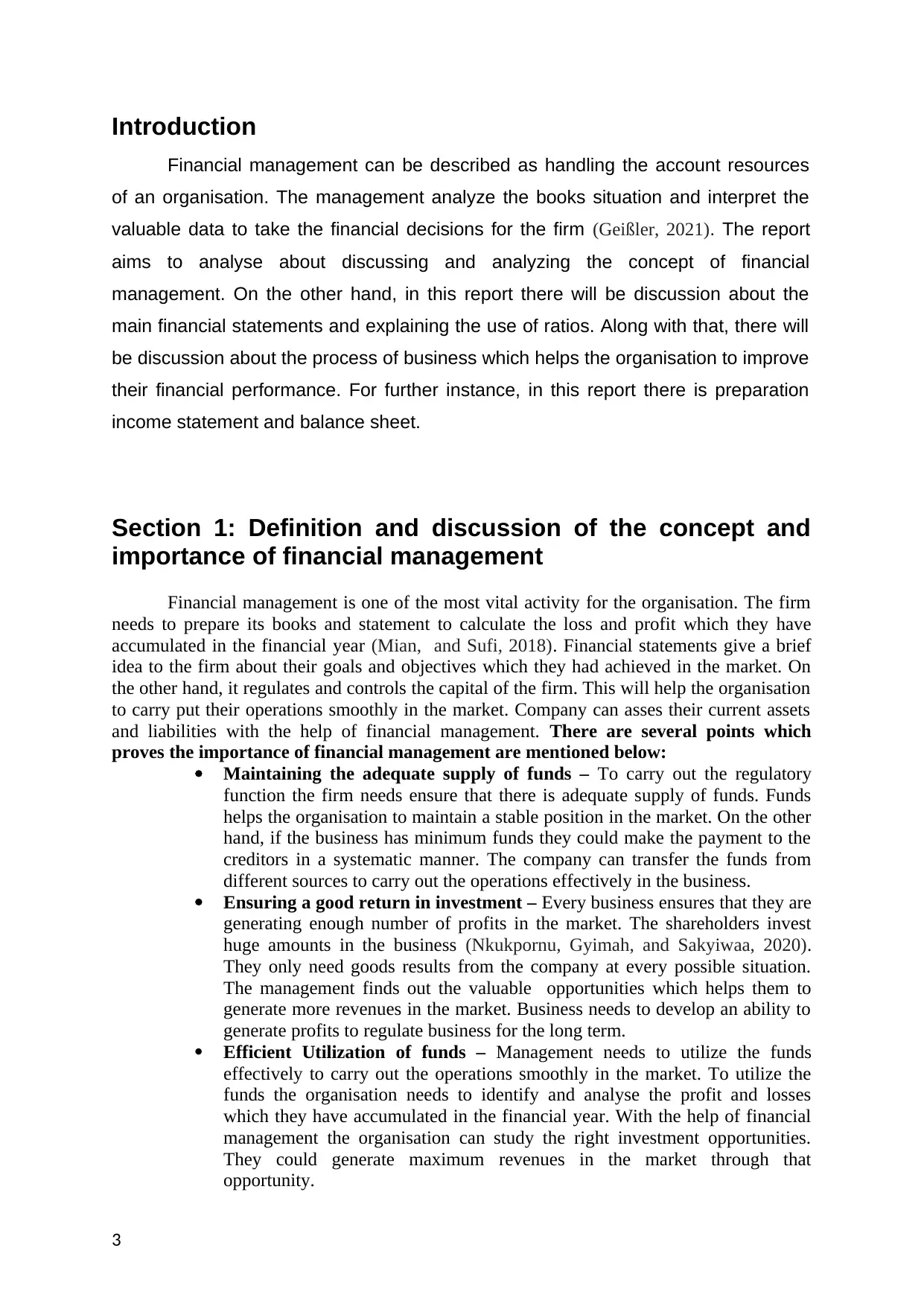
Introduction
Financial management can be described as handling the account resources
of an organisation. The management analyze the books situation and interpret the
valuable data to take the financial decisions for the firm (Geißler, 2021). The report
aims to analyse about discussing and analyzing the concept of financial
management. On the other hand, in this report there will be discussion about the
main financial statements and explaining the use of ratios. Along with that, there will
be discussion about the process of business which helps the organisation to improve
their financial performance. For further instance, in this report there is preparation
income statement and balance sheet.
Section 1: Definition and discussion of the concept and
importance of financial management
Financial management is one of the most vital activity for the organisation. The firm
needs to prepare its books and statement to calculate the loss and profit which they have
accumulated in the financial year (Mian, and Sufi, 2018). Financial statements give a brief
idea to the firm about their goals and objectives which they had achieved in the market. On
the other hand, it regulates and controls the capital of the firm. This will help the organisation
to carry put their operations smoothly in the market. Company can asses their current assets
and liabilities with the help of financial management. There are several points which
proves the importance of financial management are mentioned below:
Maintaining the adequate supply of funds – To carry out the regulatory
function the firm needs ensure that there is adequate supply of funds. Funds
helps the organisation to maintain a stable position in the market. On the other
hand, if the business has minimum funds they could make the payment to the
creditors in a systematic manner. The company can transfer the funds from
different sources to carry out the operations effectively in the business.
Ensuring a good return in investment – Every business ensures that they are
generating enough number of profits in the market. The shareholders invest
huge amounts in the business (Nkukpornu, Gyimah, and Sakyiwaa, 2020).
They only need goods results from the company at every possible situation.
The management finds out the valuable opportunities which helps them to
generate more revenues in the market. Business needs to develop an ability to
generate profits to regulate business for the long term.
Efficient Utilization of funds – Management needs to utilize the funds
effectively to carry out the operations smoothly in the market. To utilize the
funds the organisation needs to identify and analyse the profit and losses
which they have accumulated in the financial year. With the help of financial
management the organisation can study the right investment opportunities.
They could generate maximum revenues in the market through that
opportunity.
3
Financial management can be described as handling the account resources
of an organisation. The management analyze the books situation and interpret the
valuable data to take the financial decisions for the firm (Geißler, 2021). The report
aims to analyse about discussing and analyzing the concept of financial
management. On the other hand, in this report there will be discussion about the
main financial statements and explaining the use of ratios. Along with that, there will
be discussion about the process of business which helps the organisation to improve
their financial performance. For further instance, in this report there is preparation
income statement and balance sheet.
Section 1: Definition and discussion of the concept and
importance of financial management
Financial management is one of the most vital activity for the organisation. The firm
needs to prepare its books and statement to calculate the loss and profit which they have
accumulated in the financial year (Mian, and Sufi, 2018). Financial statements give a brief
idea to the firm about their goals and objectives which they had achieved in the market. On
the other hand, it regulates and controls the capital of the firm. This will help the organisation
to carry put their operations smoothly in the market. Company can asses their current assets
and liabilities with the help of financial management. There are several points which
proves the importance of financial management are mentioned below:
Maintaining the adequate supply of funds – To carry out the regulatory
function the firm needs ensure that there is adequate supply of funds. Funds
helps the organisation to maintain a stable position in the market. On the other
hand, if the business has minimum funds they could make the payment to the
creditors in a systematic manner. The company can transfer the funds from
different sources to carry out the operations effectively in the business.
Ensuring a good return in investment – Every business ensures that they are
generating enough number of profits in the market. The shareholders invest
huge amounts in the business (Nkukpornu, Gyimah, and Sakyiwaa, 2020).
They only need goods results from the company at every possible situation.
The management finds out the valuable opportunities which helps them to
generate more revenues in the market. Business needs to develop an ability to
generate profits to regulate business for the long term.
Efficient Utilization of funds – Management needs to utilize the funds
effectively to carry out the operations smoothly in the market. To utilize the
funds the organisation needs to identify and analyse the profit and losses
which they have accumulated in the financial year. With the help of financial
management the organisation can study the right investment opportunities.
They could generate maximum revenues in the market through that
opportunity.
3
⊘ This is a preview!⊘
Do you want full access?
Subscribe today to unlock all pages.

Trusted by 1+ million students worldwide
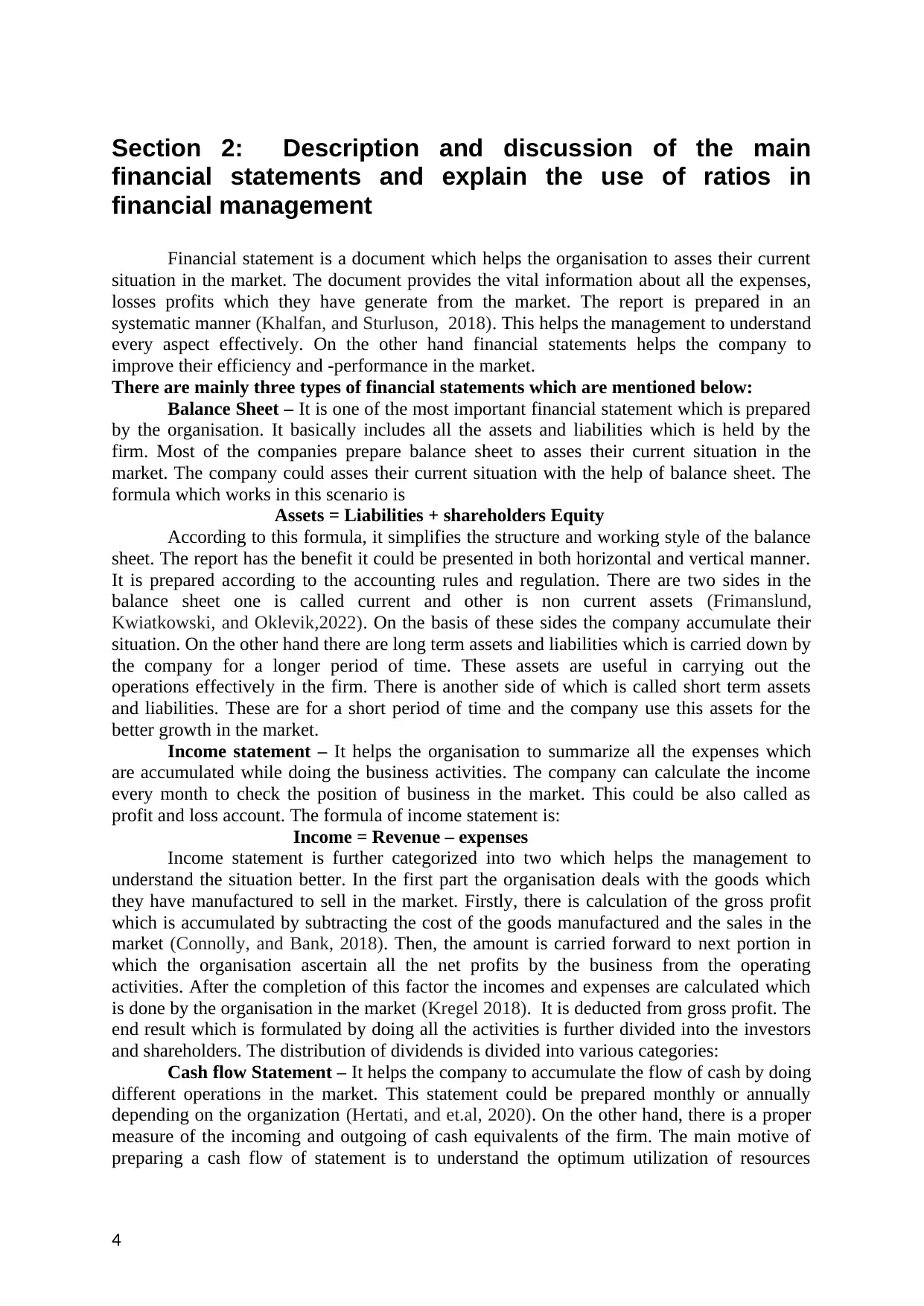
Section 2: Description and discussion of the main
financial statements and explain the use of ratios in
financial management
Financial statement is a document which helps the organisation to asses their current
situation in the market. The document provides the vital information about all the expenses,
losses profits which they have generate from the market. The report is prepared in an
systematic manner (Khalfan, and Sturluson, 2018). This helps the management to understand
every aspect effectively. On the other hand financial statements helps the company to
improve their efficiency and -performance in the market.
There are mainly three types of financial statements which are mentioned below:
Balance Sheet – It is one of the most important financial statement which is prepared
by the organisation. It basically includes all the assets and liabilities which is held by the
firm. Most of the companies prepare balance sheet to asses their current situation in the
market. The company could asses their current situation with the help of balance sheet. The
formula which works in this scenario is
Assets = Liabilities + shareholders Equity
According to this formula, it simplifies the structure and working style of the balance
sheet. The report has the benefit it could be presented in both horizontal and vertical manner.
It is prepared according to the accounting rules and regulation. There are two sides in the
balance sheet one is called current and other is non current assets (Frimanslund,
Kwiatkowski, and Oklevik,2022). On the basis of these sides the company accumulate their
situation. On the other hand there are long term assets and liabilities which is carried down by
the company for a longer period of time. These assets are useful in carrying out the
operations effectively in the firm. There is another side of which is called short term assets
and liabilities. These are for a short period of time and the company use this assets for the
better growth in the market.
Income statement – It helps the organisation to summarize all the expenses which
are accumulated while doing the business activities. The company can calculate the income
every month to check the position of business in the market. This could be also called as
profit and loss account. The formula of income statement is:
Income = Revenue – expenses
Income statement is further categorized into two which helps the management to
understand the situation better. In the first part the organisation deals with the goods which
they have manufactured to sell in the market. Firstly, there is calculation of the gross profit
which is accumulated by subtracting the cost of the goods manufactured and the sales in the
market (Connolly, and Bank, 2018). Then, the amount is carried forward to next portion in
which the organisation ascertain all the net profits by the business from the operating
activities. After the completion of this factor the incomes and expenses are calculated which
is done by the organisation in the market (Kregel 2018). It is deducted from gross profit. The
end result which is formulated by doing all the activities is further divided into the investors
and shareholders. The distribution of dividends is divided into various categories:
Cash flow Statement – It helps the company to accumulate the flow of cash by doing
different operations in the market. This statement could be prepared monthly or annually
depending on the organization (Hertati, and et.al, 2020). On the other hand, there is a proper
measure of the incoming and outgoing of cash equivalents of the firm. The main motive of
preparing a cash flow of statement is to understand the optimum utilization of resources
4
financial statements and explain the use of ratios in
financial management
Financial statement is a document which helps the organisation to asses their current
situation in the market. The document provides the vital information about all the expenses,
losses profits which they have generate from the market. The report is prepared in an
systematic manner (Khalfan, and Sturluson, 2018). This helps the management to understand
every aspect effectively. On the other hand financial statements helps the company to
improve their efficiency and -performance in the market.
There are mainly three types of financial statements which are mentioned below:
Balance Sheet – It is one of the most important financial statement which is prepared
by the organisation. It basically includes all the assets and liabilities which is held by the
firm. Most of the companies prepare balance sheet to asses their current situation in the
market. The company could asses their current situation with the help of balance sheet. The
formula which works in this scenario is
Assets = Liabilities + shareholders Equity
According to this formula, it simplifies the structure and working style of the balance
sheet. The report has the benefit it could be presented in both horizontal and vertical manner.
It is prepared according to the accounting rules and regulation. There are two sides in the
balance sheet one is called current and other is non current assets (Frimanslund,
Kwiatkowski, and Oklevik,2022). On the basis of these sides the company accumulate their
situation. On the other hand there are long term assets and liabilities which is carried down by
the company for a longer period of time. These assets are useful in carrying out the
operations effectively in the firm. There is another side of which is called short term assets
and liabilities. These are for a short period of time and the company use this assets for the
better growth in the market.
Income statement – It helps the organisation to summarize all the expenses which
are accumulated while doing the business activities. The company can calculate the income
every month to check the position of business in the market. This could be also called as
profit and loss account. The formula of income statement is:
Income = Revenue – expenses
Income statement is further categorized into two which helps the management to
understand the situation better. In the first part the organisation deals with the goods which
they have manufactured to sell in the market. Firstly, there is calculation of the gross profit
which is accumulated by subtracting the cost of the goods manufactured and the sales in the
market (Connolly, and Bank, 2018). Then, the amount is carried forward to next portion in
which the organisation ascertain all the net profits by the business from the operating
activities. After the completion of this factor the incomes and expenses are calculated which
is done by the organisation in the market (Kregel 2018). It is deducted from gross profit. The
end result which is formulated by doing all the activities is further divided into the investors
and shareholders. The distribution of dividends is divided into various categories:
Cash flow Statement – It helps the company to accumulate the flow of cash by doing
different operations in the market. This statement could be prepared monthly or annually
depending on the organization (Hertati, and et.al, 2020). On the other hand, there is a proper
measure of the incoming and outgoing of cash equivalents of the firm. The main motive of
preparing a cash flow of statement is to understand the optimum utilization of resources
4
Paraphrase This Document
Need a fresh take? Get an instant paraphrase of this document with our AI Paraphraser
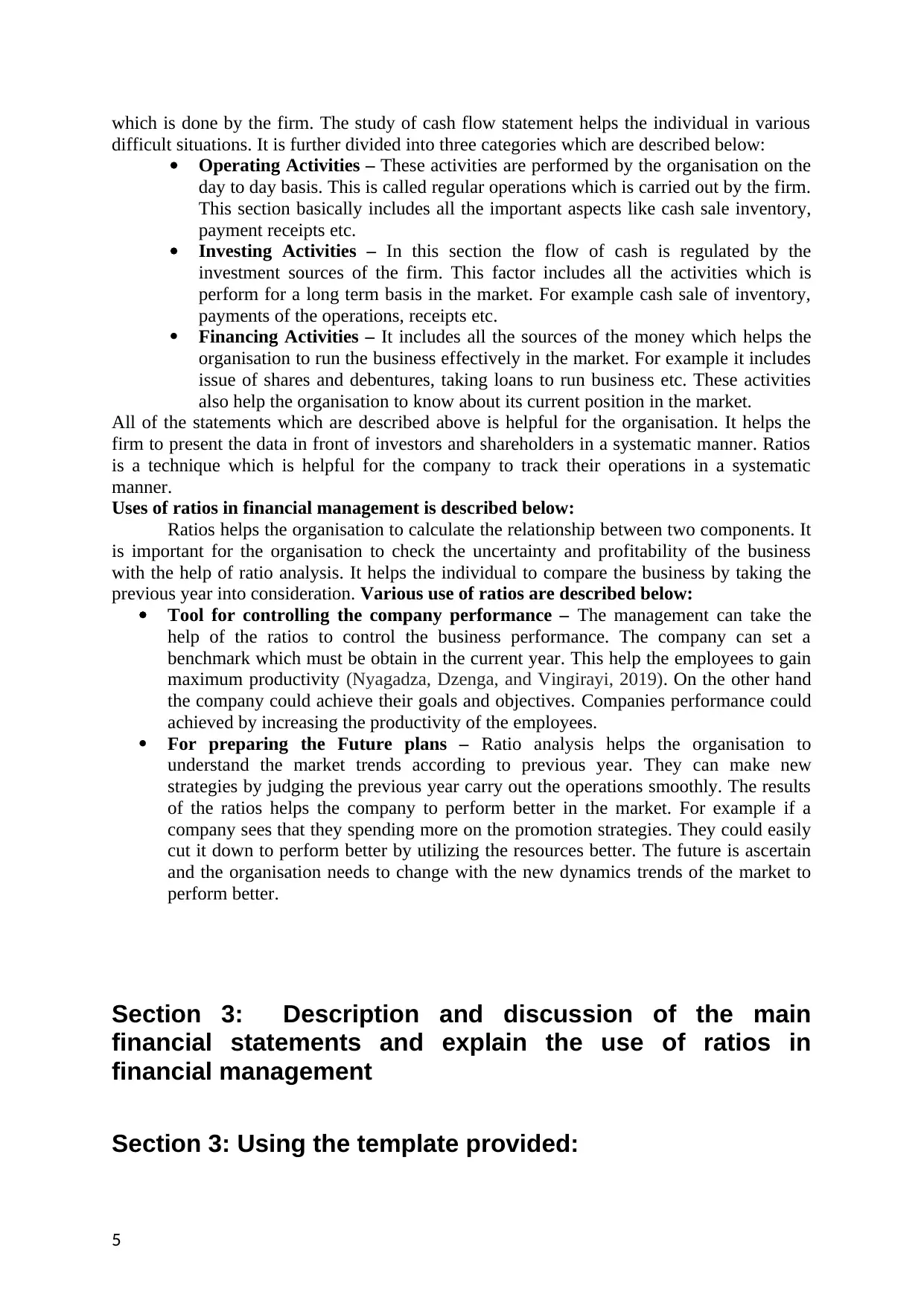
which is done by the firm. The study of cash flow statement helps the individual in various
difficult situations. It is further divided into three categories which are described below:
Operating Activities – These activities are performed by the organisation on the
day to day basis. This is called regular operations which is carried out by the firm.
This section basically includes all the important aspects like cash sale inventory,
payment receipts etc.
Investing Activities – In this section the flow of cash is regulated by the
investment sources of the firm. This factor includes all the activities which is
perform for a long term basis in the market. For example cash sale of inventory,
payments of the operations, receipts etc.
Financing Activities – It includes all the sources of the money which helps the
organisation to run the business effectively in the market. For example it includes
issue of shares and debentures, taking loans to run business etc. These activities
also help the organisation to know about its current position in the market.
All of the statements which are described above is helpful for the organisation. It helps the
firm to present the data in front of investors and shareholders in a systematic manner. Ratios
is a technique which is helpful for the company to track their operations in a systematic
manner.
Uses of ratios in financial management is described below:
Ratios helps the organisation to calculate the relationship between two components. It
is important for the organisation to check the uncertainty and profitability of the business
with the help of ratio analysis. It helps the individual to compare the business by taking the
previous year into consideration. Various use of ratios are described below:
Tool for controlling the company performance – The management can take the
help of the ratios to control the business performance. The company can set a
benchmark which must be obtain in the current year. This help the employees to gain
maximum productivity (Nyagadza, Dzenga, and Vingirayi, 2019). On the other hand
the company could achieve their goals and objectives. Companies performance could
achieved by increasing the productivity of the employees.
For preparing the Future plans – Ratio analysis helps the organisation to
understand the market trends according to previous year. They can make new
strategies by judging the previous year carry out the operations smoothly. The results
of the ratios helps the company to perform better in the market. For example if a
company sees that they spending more on the promotion strategies. They could easily
cut it down to perform better by utilizing the resources better. The future is ascertain
and the organisation needs to change with the new dynamics trends of the market to
perform better.
Section 3: Description and discussion of the main
financial statements and explain the use of ratios in
financial management
Section 3: Using the template provided:
5
difficult situations. It is further divided into three categories which are described below:
Operating Activities – These activities are performed by the organisation on the
day to day basis. This is called regular operations which is carried out by the firm.
This section basically includes all the important aspects like cash sale inventory,
payment receipts etc.
Investing Activities – In this section the flow of cash is regulated by the
investment sources of the firm. This factor includes all the activities which is
perform for a long term basis in the market. For example cash sale of inventory,
payments of the operations, receipts etc.
Financing Activities – It includes all the sources of the money which helps the
organisation to run the business effectively in the market. For example it includes
issue of shares and debentures, taking loans to run business etc. These activities
also help the organisation to know about its current position in the market.
All of the statements which are described above is helpful for the organisation. It helps the
firm to present the data in front of investors and shareholders in a systematic manner. Ratios
is a technique which is helpful for the company to track their operations in a systematic
manner.
Uses of ratios in financial management is described below:
Ratios helps the organisation to calculate the relationship between two components. It
is important for the organisation to check the uncertainty and profitability of the business
with the help of ratio analysis. It helps the individual to compare the business by taking the
previous year into consideration. Various use of ratios are described below:
Tool for controlling the company performance – The management can take the
help of the ratios to control the business performance. The company can set a
benchmark which must be obtain in the current year. This help the employees to gain
maximum productivity (Nyagadza, Dzenga, and Vingirayi, 2019). On the other hand
the company could achieve their goals and objectives. Companies performance could
achieved by increasing the productivity of the employees.
For preparing the Future plans – Ratio analysis helps the organisation to
understand the market trends according to previous year. They can make new
strategies by judging the previous year carry out the operations smoothly. The results
of the ratios helps the company to perform better in the market. For example if a
company sees that they spending more on the promotion strategies. They could easily
cut it down to perform better by utilizing the resources better. The future is ascertain
and the organisation needs to change with the new dynamics trends of the market to
perform better.
Section 3: Description and discussion of the main
financial statements and explain the use of ratios in
financial management
Section 3: Using the template provided:
5
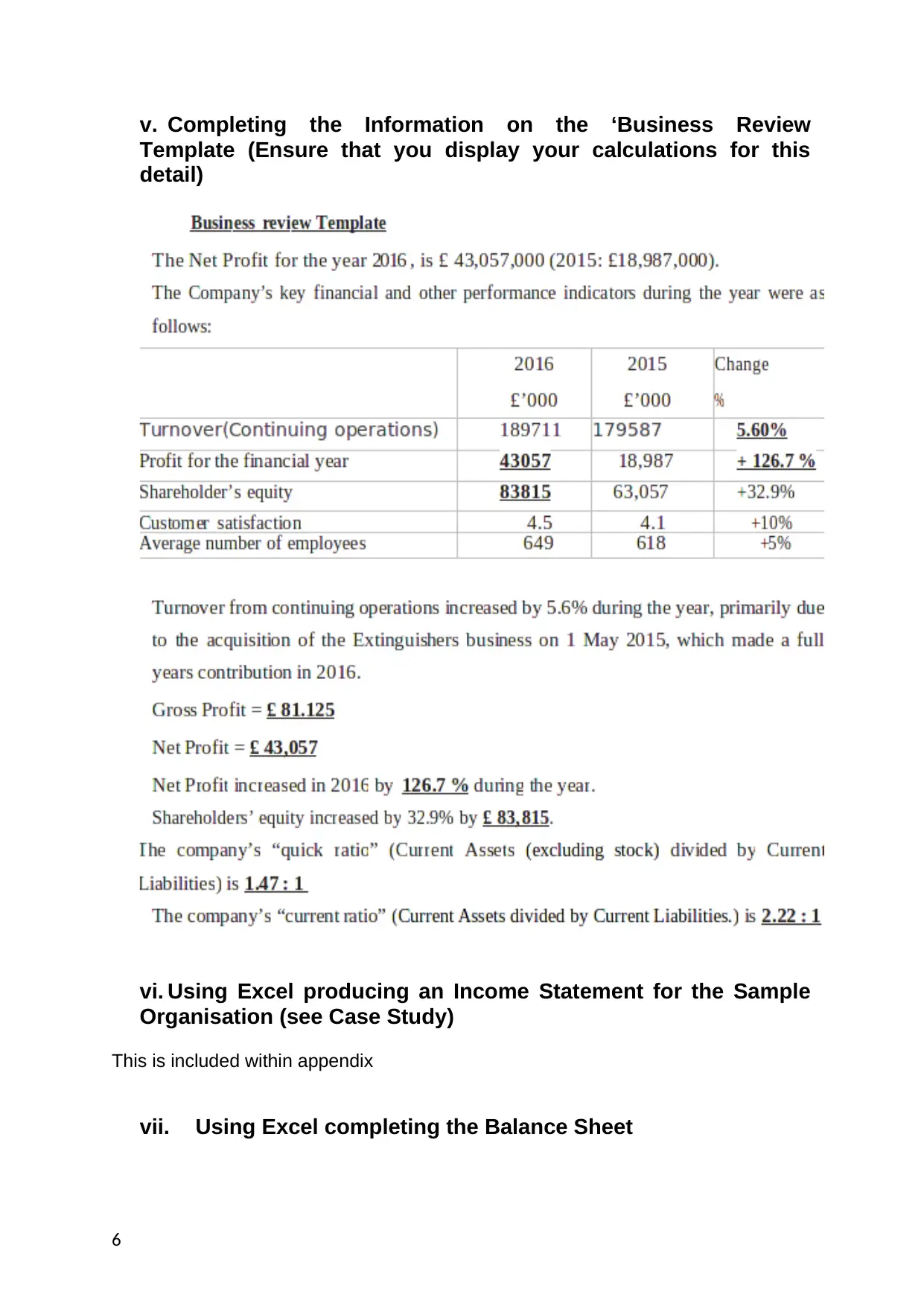
v. Completing the Information on the ‘Business Review
Template (Ensure that you display your calculations for this
detail)
vi. Using Excel producing an Income Statement for the Sample
Organisation (see Case Study)
This is included within appendix
vii. Using Excel completing the Balance Sheet
6
Template (Ensure that you display your calculations for this
detail)
vi. Using Excel producing an Income Statement for the Sample
Organisation (see Case Study)
This is included within appendix
vii. Using Excel completing the Balance Sheet
6
⊘ This is a preview!⊘
Do you want full access?
Subscribe today to unlock all pages.

Trusted by 1+ million students worldwide
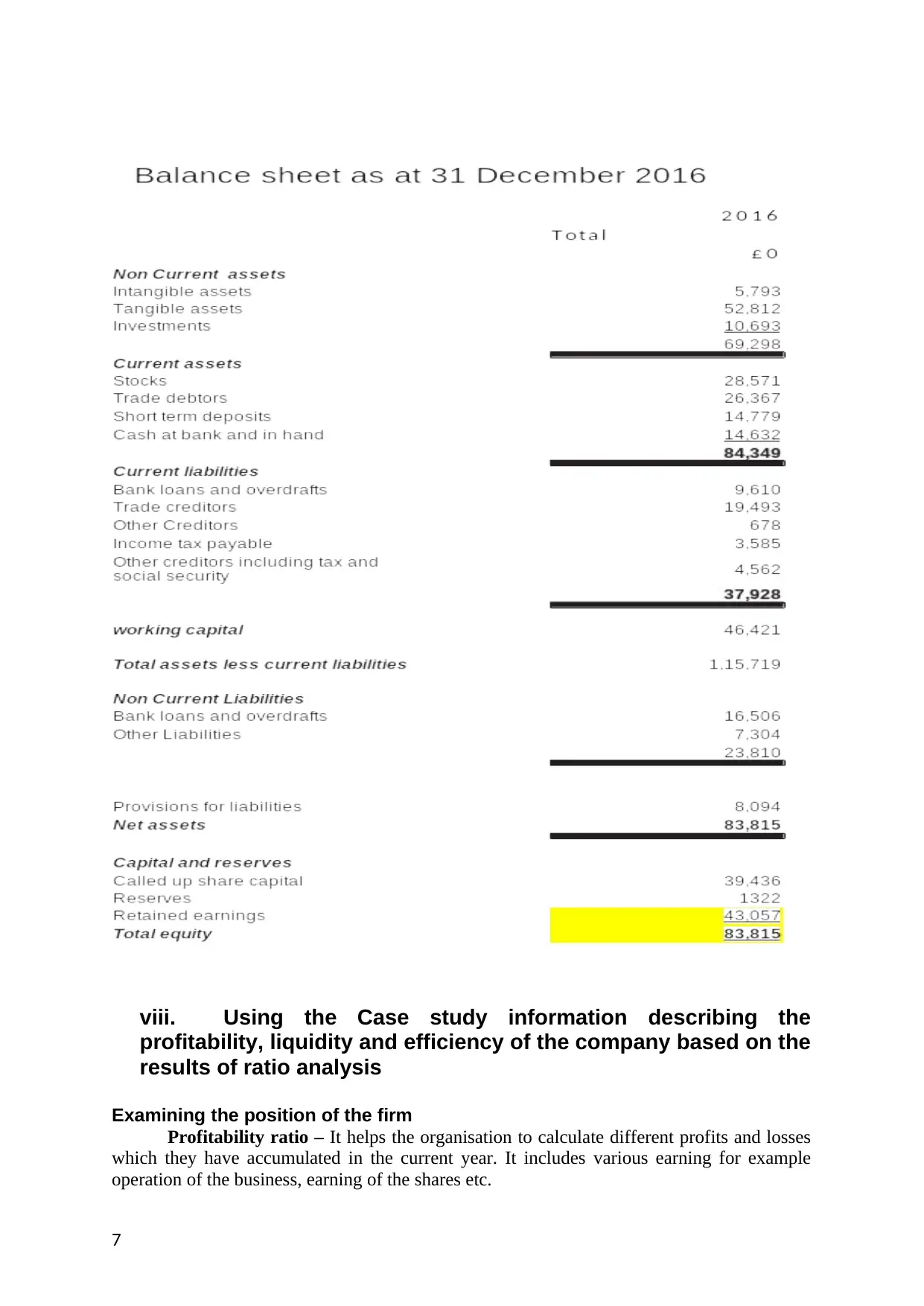
viii. Using the Case study information describing the
profitability, liquidity and efficiency of the company based on the
results of ratio analysis
Examining the position of the firm
Profitability ratio – It helps the organisation to calculate different profits and losses
which they have accumulated in the current year. It includes various earning for example
operation of the business, earning of the shares etc.
7
profitability, liquidity and efficiency of the company based on the
results of ratio analysis
Examining the position of the firm
Profitability ratio – It helps the organisation to calculate different profits and losses
which they have accumulated in the current year. It includes various earning for example
operation of the business, earning of the shares etc.
7
Paraphrase This Document
Need a fresh take? Get an instant paraphrase of this document with our AI Paraphraser
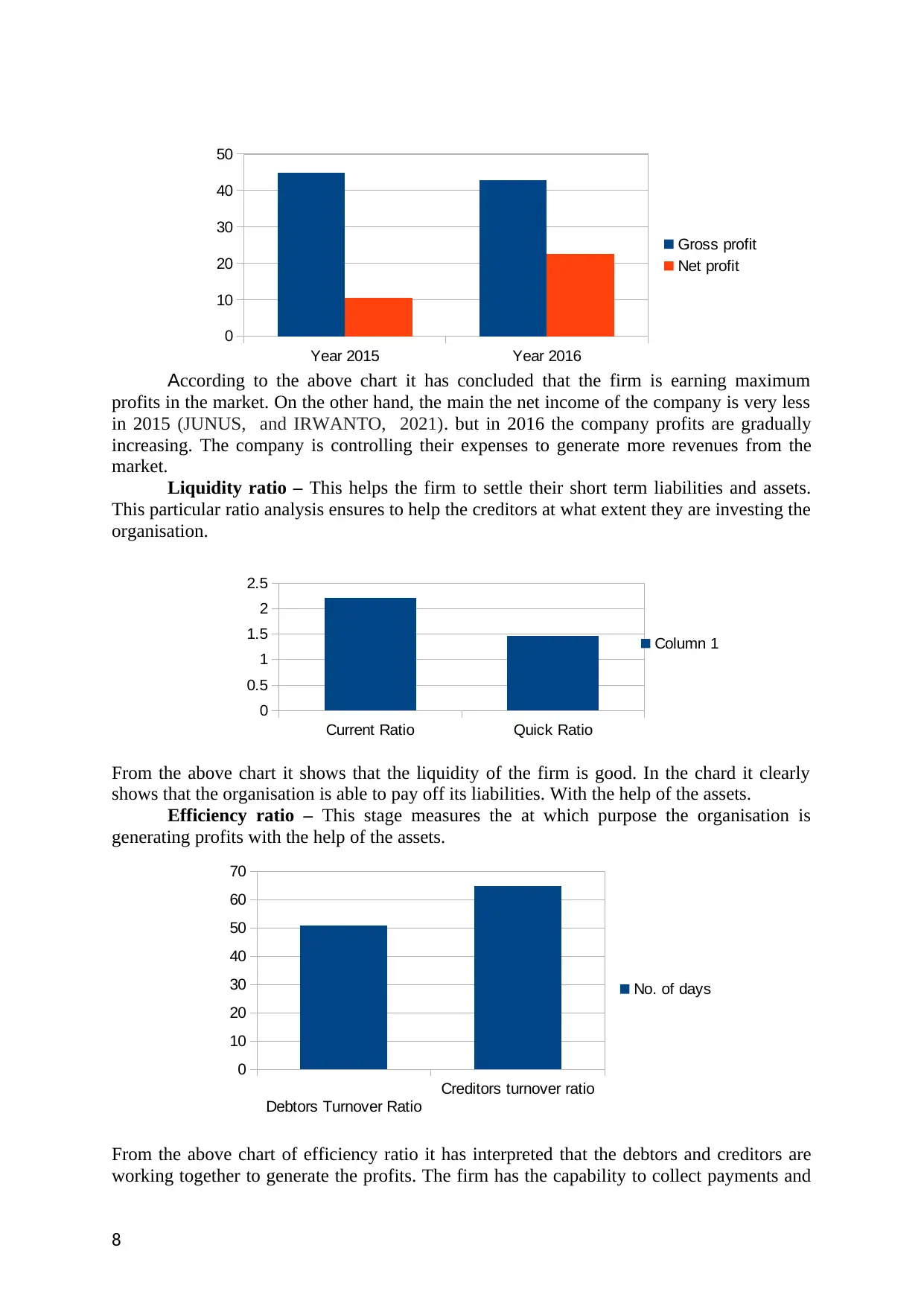
According to the above chart it has concluded that the firm is earning maximum
profits in the market. On the other hand, the main the net income of the company is very less
in 2015 (JUNUS, and IRWANTO, 2021). but in 2016 the company profits are gradually
increasing. The company is controlling their expenses to generate more revenues from the
market.
Liquidity ratio – This helps the firm to settle their short term liabilities and assets.
This particular ratio analysis ensures to help the creditors at what extent they are investing the
organisation.
From the above chart it shows that the liquidity of the firm is good. In the chard it clearly
shows that the organisation is able to pay off its liabilities. With the help of the assets.
Efficiency ratio – This stage measures the at which purpose the organisation is
generating profits with the help of the assets.
From the above chart of efficiency ratio it has interpreted that the debtors and creditors are
working together to generate the profits. The firm has the capability to collect payments and
8
Year 2015 Year 2016
0
10
20
30
40
50
Gross profit
Net profit
Current Ratio Quick Ratio
0
0.5
1
1.5
2
2.5
Column 1
Debtors Turnover Ratio
Creditors turnover ratio
0
10
20
30
40
50
60
70
No. of days
profits in the market. On the other hand, the main the net income of the company is very less
in 2015 (JUNUS, and IRWANTO, 2021). but in 2016 the company profits are gradually
increasing. The company is controlling their expenses to generate more revenues from the
market.
Liquidity ratio – This helps the firm to settle their short term liabilities and assets.
This particular ratio analysis ensures to help the creditors at what extent they are investing the
organisation.
From the above chart it shows that the liquidity of the firm is good. In the chard it clearly
shows that the organisation is able to pay off its liabilities. With the help of the assets.
Efficiency ratio – This stage measures the at which purpose the organisation is
generating profits with the help of the assets.
From the above chart of efficiency ratio it has interpreted that the debtors and creditors are
working together to generate the profits. The firm has the capability to collect payments and
8
Year 2015 Year 2016
0
10
20
30
40
50
Gross profit
Net profit
Current Ratio Quick Ratio
0
0.5
1
1.5
2
2.5
Column 1
Debtors Turnover Ratio
Creditors turnover ratio
0
10
20
30
40
50
60
70
No. of days
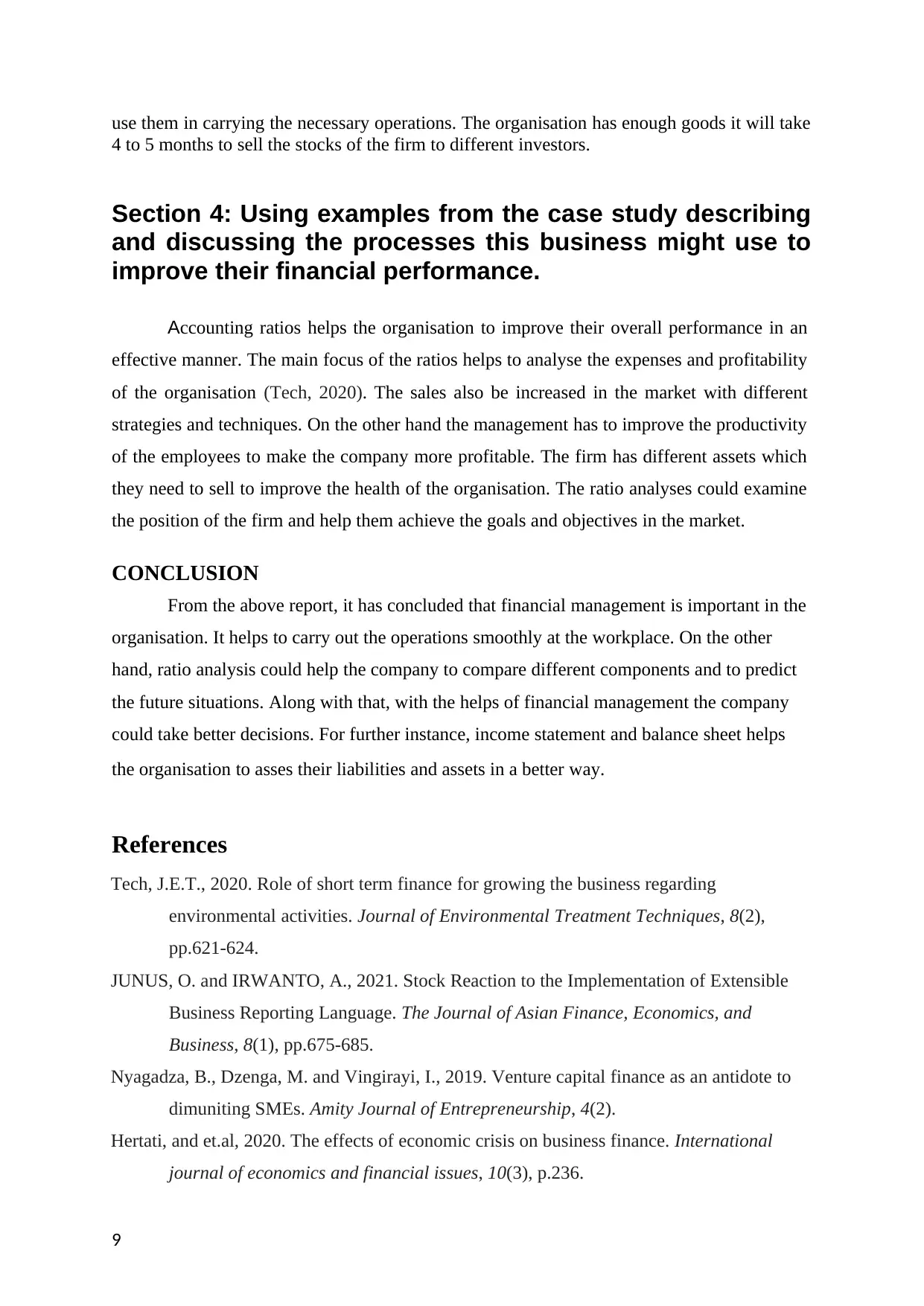
use them in carrying the necessary operations. The organisation has enough goods it will take
4 to 5 months to sell the stocks of the firm to different investors.
Section 4: Using examples from the case study describing
and discussing the processes this business might use to
improve their financial performance.
Accounting ratios helps the organisation to improve their overall performance in an
effective manner. The main focus of the ratios helps to analyse the expenses and profitability
of the organisation (Tech, 2020). The sales also be increased in the market with different
strategies and techniques. On the other hand the management has to improve the productivity
of the employees to make the company more profitable. The firm has different assets which
they need to sell to improve the health of the organisation. The ratio analyses could examine
the position of the firm and help them achieve the goals and objectives in the market.
CONCLUSION
From the above report, it has concluded that financial management is important in the
organisation. It helps to carry out the operations smoothly at the workplace. On the other
hand, ratio analysis could help the company to compare different components and to predict
the future situations. Along with that, with the helps of financial management the company
could take better decisions. For further instance, income statement and balance sheet helps
the organisation to asses their liabilities and assets in a better way.
References
Tech, J.E.T., 2020. Role of short term finance for growing the business regarding
environmental activities. Journal of Environmental Treatment Techniques, 8(2),
pp.621-624.
JUNUS, O. and IRWANTO, A., 2021. Stock Reaction to the Implementation of Extensible
Business Reporting Language. The Journal of Asian Finance, Economics, and
Business, 8(1), pp.675-685.
Nyagadza, B., Dzenga, M. and Vingirayi, I., 2019. Venture capital finance as an antidote to
dimuniting SMEs. Amity Journal of Entrepreneurship, 4(2).
Hertati, and et.al, 2020. The effects of economic crisis on business finance. International
journal of economics and financial issues, 10(3), p.236.
9
4 to 5 months to sell the stocks of the firm to different investors.
Section 4: Using examples from the case study describing
and discussing the processes this business might use to
improve their financial performance.
Accounting ratios helps the organisation to improve their overall performance in an
effective manner. The main focus of the ratios helps to analyse the expenses and profitability
of the organisation (Tech, 2020). The sales also be increased in the market with different
strategies and techniques. On the other hand the management has to improve the productivity
of the employees to make the company more profitable. The firm has different assets which
they need to sell to improve the health of the organisation. The ratio analyses could examine
the position of the firm and help them achieve the goals and objectives in the market.
CONCLUSION
From the above report, it has concluded that financial management is important in the
organisation. It helps to carry out the operations smoothly at the workplace. On the other
hand, ratio analysis could help the company to compare different components and to predict
the future situations. Along with that, with the helps of financial management the company
could take better decisions. For further instance, income statement and balance sheet helps
the organisation to asses their liabilities and assets in a better way.
References
Tech, J.E.T., 2020. Role of short term finance for growing the business regarding
environmental activities. Journal of Environmental Treatment Techniques, 8(2),
pp.621-624.
JUNUS, O. and IRWANTO, A., 2021. Stock Reaction to the Implementation of Extensible
Business Reporting Language. The Journal of Asian Finance, Economics, and
Business, 8(1), pp.675-685.
Nyagadza, B., Dzenga, M. and Vingirayi, I., 2019. Venture capital finance as an antidote to
dimuniting SMEs. Amity Journal of Entrepreneurship, 4(2).
Hertati, and et.al, 2020. The effects of economic crisis on business finance. International
journal of economics and financial issues, 10(3), p.236.
9
⊘ This is a preview!⊘
Do you want full access?
Subscribe today to unlock all pages.

Trusted by 1+ million students worldwide
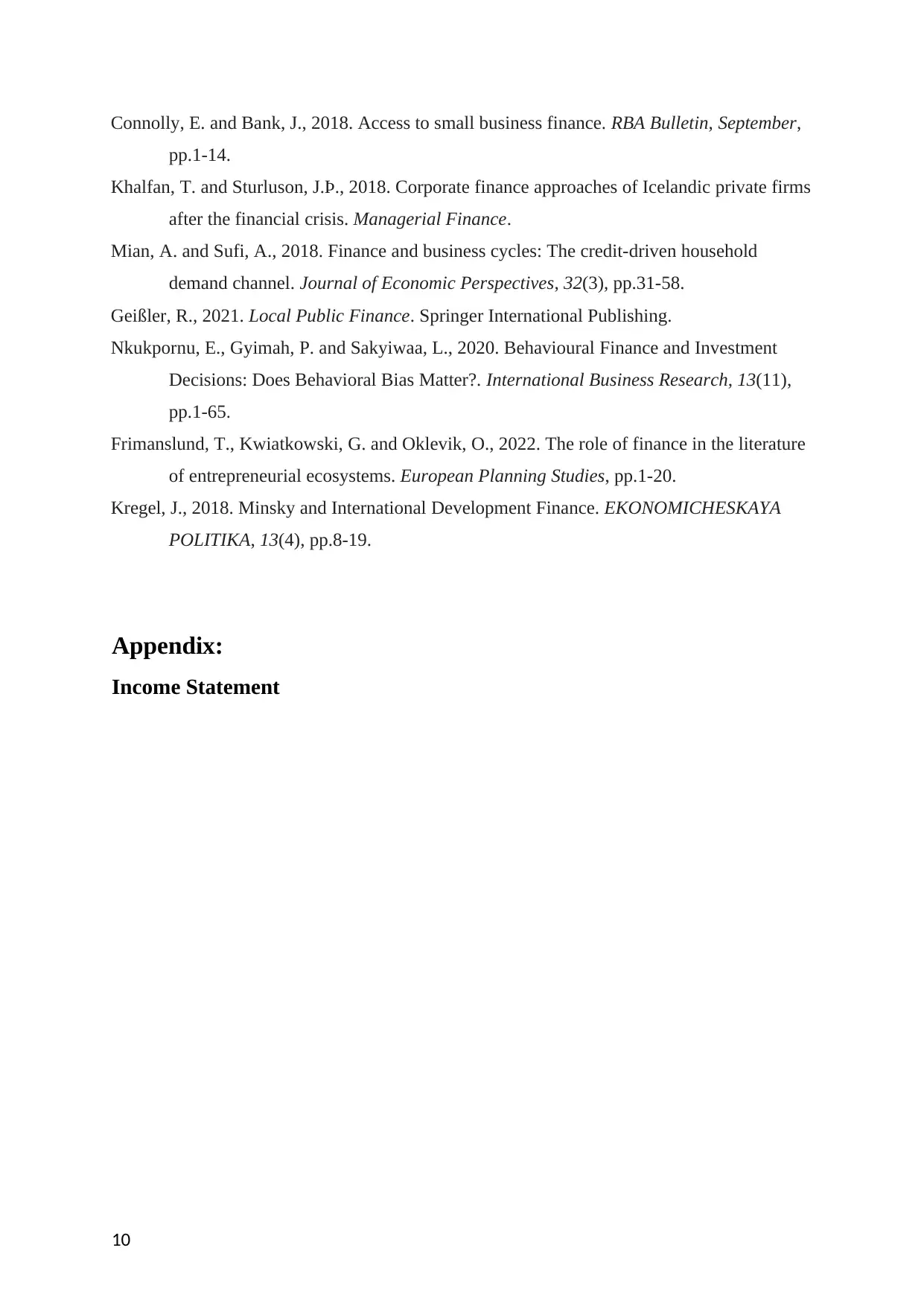
Connolly, E. and Bank, J., 2018. Access to small business finance. RBA Bulletin, September,
pp.1-14.
Khalfan, T. and Sturluson, J.Þ., 2018. Corporate finance approaches of Icelandic private firms
after the financial crisis. Managerial Finance.
Mian, A. and Sufi, A., 2018. Finance and business cycles: The credit-driven household
demand channel. Journal of Economic Perspectives, 32(3), pp.31-58.
Geißler, R., 2021. Local Public Finance. Springer International Publishing.
Nkukpornu, E., Gyimah, P. and Sakyiwaa, L., 2020. Behavioural Finance and Investment
Decisions: Does Behavioral Bias Matter?. International Business Research, 13(11),
pp.1-65.
Frimanslund, T., Kwiatkowski, G. and Oklevik, O., 2022. The role of finance in the literature
of entrepreneurial ecosystems. European Planning Studies, pp.1-20.
Kregel, J., 2018. Minsky and International Development Finance. EKONOMICHESKAYA
POLITIKA, 13(4), pp.8-19.
Appendix:
Income Statement
10
pp.1-14.
Khalfan, T. and Sturluson, J.Þ., 2018. Corporate finance approaches of Icelandic private firms
after the financial crisis. Managerial Finance.
Mian, A. and Sufi, A., 2018. Finance and business cycles: The credit-driven household
demand channel. Journal of Economic Perspectives, 32(3), pp.31-58.
Geißler, R., 2021. Local Public Finance. Springer International Publishing.
Nkukpornu, E., Gyimah, P. and Sakyiwaa, L., 2020. Behavioural Finance and Investment
Decisions: Does Behavioral Bias Matter?. International Business Research, 13(11),
pp.1-65.
Frimanslund, T., Kwiatkowski, G. and Oklevik, O., 2022. The role of finance in the literature
of entrepreneurial ecosystems. European Planning Studies, pp.1-20.
Kregel, J., 2018. Minsky and International Development Finance. EKONOMICHESKAYA
POLITIKA, 13(4), pp.8-19.
Appendix:
Income Statement
10
Paraphrase This Document
Need a fresh take? Get an instant paraphrase of this document with our AI Paraphraser
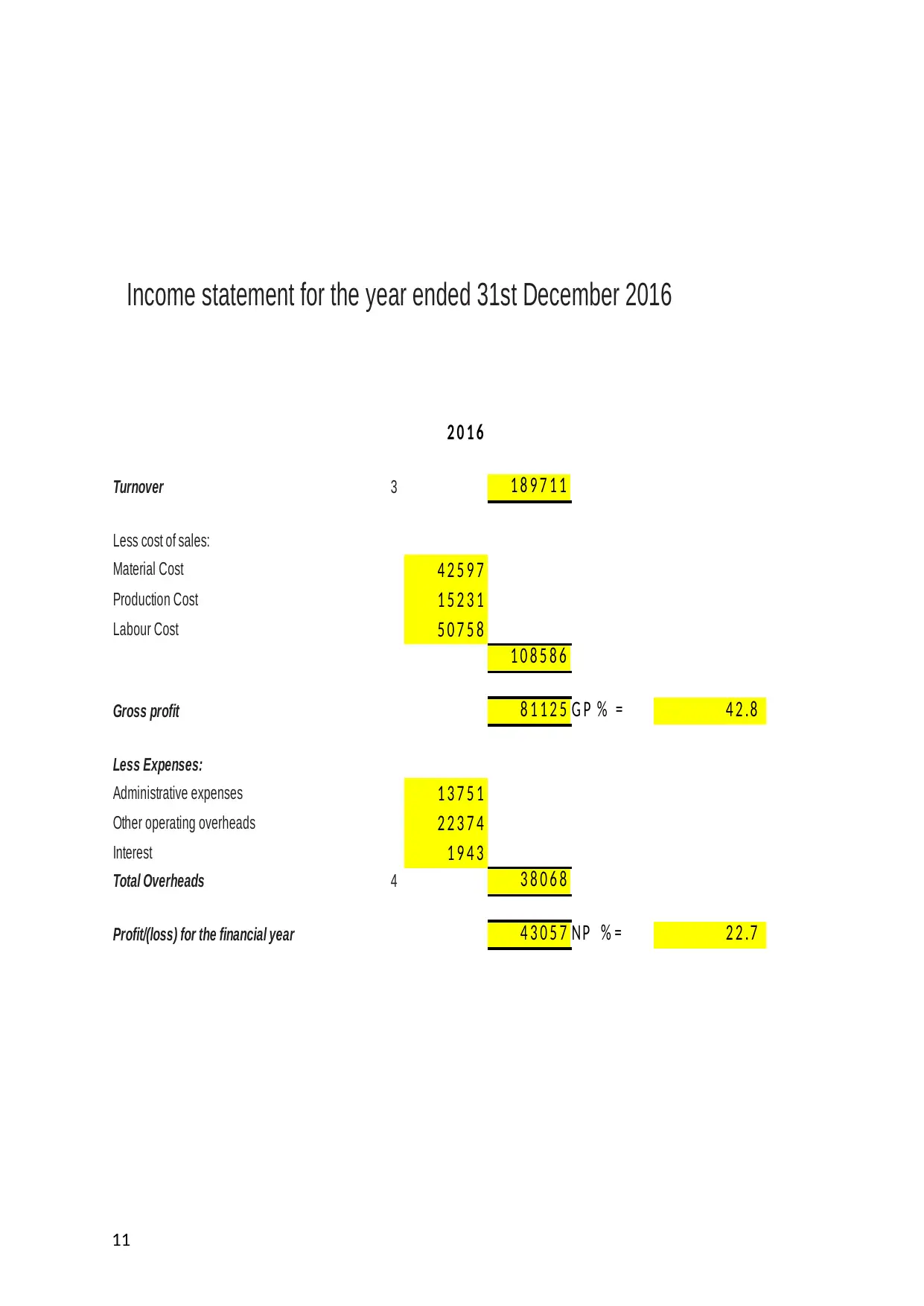
Income statement for the year ended 31st December 2016
2 0 1 6
Turnover 3 1 8 9 7 1 1
Less cost of sales:
Material Cost 4 2 5 9 7
Production Cost 1 5 2 3 1
Labour Cost 5 0 7 5 8
1 0 8 5 8 6
Gross profit 8 1 1 2 5 G P % = 4 2 .8
Less Expenses:
Administrative expenses 1 3 7 5 1
Other operating overheads 2 2 3 7 4
Interest 1 9 4 3
Total Overheads 4 3 8 0 6 8
Profit/(loss) for the financial year 4 3 0 5 7 N P % = 2 2 .7
11
2 0 1 6
Turnover 3 1 8 9 7 1 1
Less cost of sales:
Material Cost 4 2 5 9 7
Production Cost 1 5 2 3 1
Labour Cost 5 0 7 5 8
1 0 8 5 8 6
Gross profit 8 1 1 2 5 G P % = 4 2 .8
Less Expenses:
Administrative expenses 1 3 7 5 1
Other operating overheads 2 2 3 7 4
Interest 1 9 4 3
Total Overheads 4 3 8 0 6 8
Profit/(loss) for the financial year 4 3 0 5 7 N P % = 2 2 .7
11
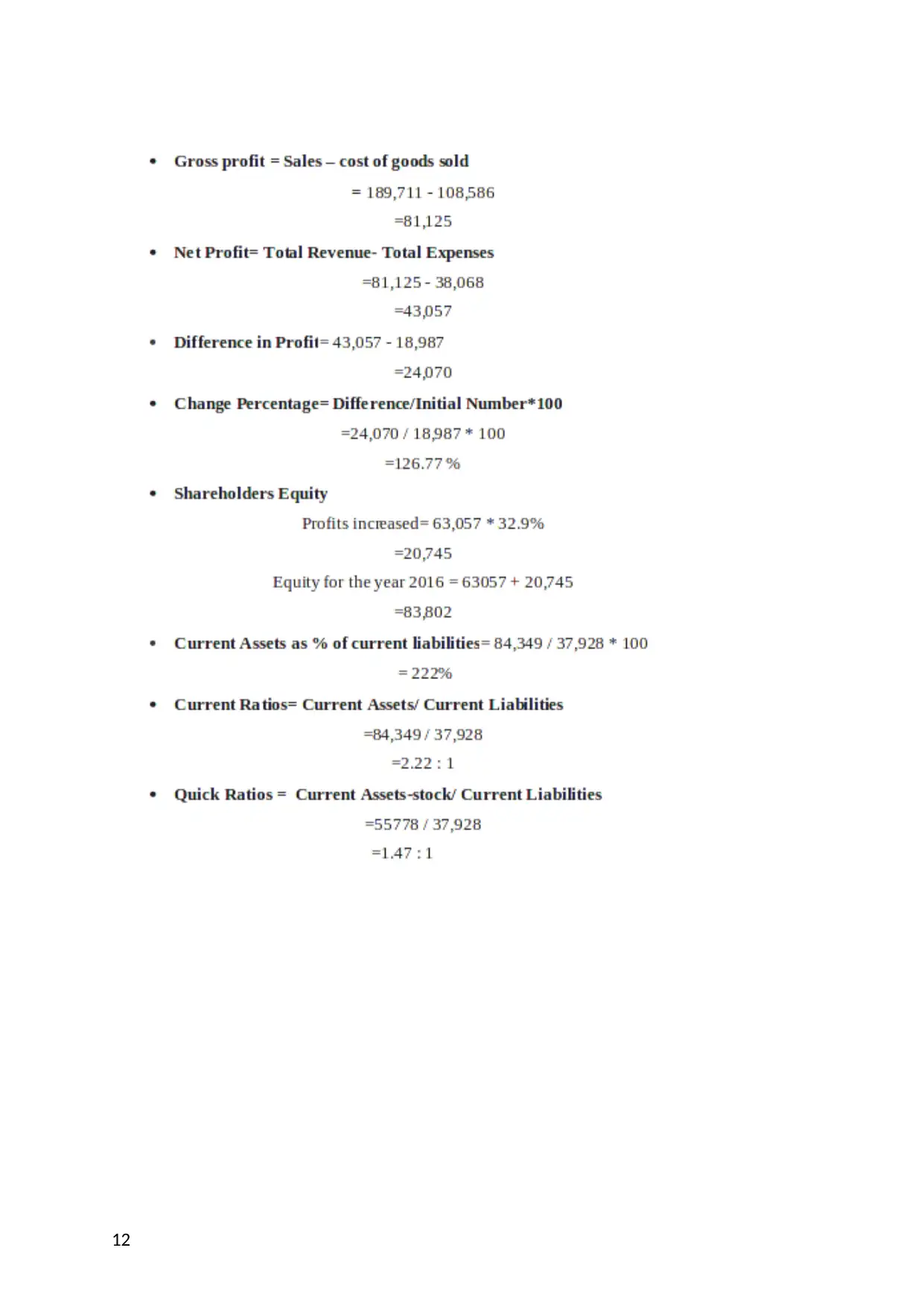
12
⊘ This is a preview!⊘
Do you want full access?
Subscribe today to unlock all pages.

Trusted by 1+ million students worldwide
1 out of 13
Related Documents
Your All-in-One AI-Powered Toolkit for Academic Success.
+13062052269
info@desklib.com
Available 24*7 on WhatsApp / Email
![[object Object]](/_next/static/media/star-bottom.7253800d.svg)
Unlock your academic potential
Copyright © 2020–2025 A2Z Services. All Rights Reserved. Developed and managed by ZUCOL.


